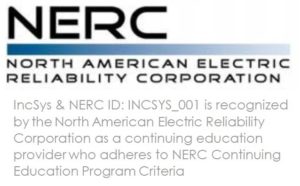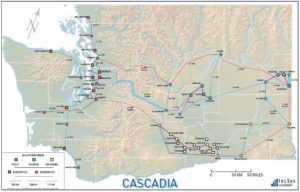 Line Outage Distribution Factors
Line Outage Distribution Factors
Course NERC Continued Educational Hours: OT: 2; Stand: .5; SIM: 1.5
This is a NERC Continued Educational computer-based training module which consists of a video lecture and two simulation exercises. Students watch a video lecture explaining the concept of generation redispatch as a tool for transmission operators to reduced overloaded transmission line conditions and the applicable requirements from TOP-001. The instructor describes the conditions where generation redispatch is effective, including reducing MW flow, providing MVAR resources, and decreased bus angle differences and also provides guidelines for applying generation dispatch using diagrams. They also define generation shift factor (GSF) and how it affects a network and how network topology changes GSFs. The instructor provides several examples from a hypothetical power system on how to calculate GSF and students will apply the concepts of Line Outage Distribution Factors to a hypothetical power system while reacting to a brush fire event that leads to transmission line outages. An Electrical Distance Diagram is used by students to calculate the LODF on designated transmission lines and they will use the LODF and simulator data to predict the flow on parallel lines when other lines are removed from service. Students then remove the line and compare the simulator results to their calculations. This process is repeated for different configurations with multiple, non-identical, parallel paths. Students will perform a more complicated simulation exercise where they calculate Line Outage Distribution Factors and apply them to multiple paths as they prepare for the outage of a major transmission corridor. Students use the equivalent 230 kV line lengths to accurately estimate the amount of MW flow that will move to another two parallel paths as each transmission line is removed from service.
Cascadia 4050 – Course Objectives
Line Outage Distribution Factors
- Identify the correct definitions for Line Outage Distribution Factor (LODF) and Generation Shift Factor (GSF).
- Choose the maximum line loading that should be placed on lines in parallel to avoid an overloading contingency.
- Calculate the LODF based on hypothetical conditions.
- Use an LODF to calculate the change in loading on a transmission line.
- Identify the conditions that affect LODFs and GSFs.
- Recall the conditions and time requirements for NERC TOP-001 standard and how LODFs and GSFs can be used to comply with those standards.
- Determine the LODFs for parallel transmissions lines when there are no other parallel loops.
- Determine the LODFs from an Electrical Distance Diagrams for parallel transmissions lines when there is a one other significant parallel loop.
- Apply the LODFs to calculate post-contingent MW flows when there are single and multiple contingencies.
- Compare the flows calculated using LODFs with the values measured from PowerSimulator.
- Respond to multiple contingencies that create SOL violations.
- Identify a Generation Shed and Load Shed plan when a Line Load Dump limit is exceeded.
- Determine the PTDFs for Generation and Load Shed plan from the Cascadia Electrical Distance Diagram.
- Use the PTDFs to determine the magnitude of the Generation and Load Shed to eliminate the SOL violation.
- Use the PTDF to estimate the MW flows on the element with the SOL violation after Generation and Load Shed is implemented.
- Implement the Generation and Load Shed Plan.
- Measure flows after the Generation and Load Shed plan.
- Compare the measured flows with the estimates based on the PTDFs.
- Compare the PTDFs calculated from the before and after PowerSimulator measurements with the PTDFs calculated from the Electrical Distance Diagram.
Downloadable 4050 Course Flyer
Subject Matter Expert
This course listed is a NERC CE approved continuing education course which will help you obtain the required NERC CE Credit Hours for maintaining the validity of your NERC Certification.
End of Course Instructions
After successful completion of the course the certificate of completion will be available for download and print from your training homepage.
After successful completion of this course your credits will be automatically reported for NERC CE Credits via the NERC SOCCED reporting tool. IncSys Academy also has a policy where credits will be manually reported via SOCCED on a WEEKLY basis (every Monday). It is critical that each candidate provide IncSys Academy with their proper credentials to ensure that proper credits are reported to your SOCCED account. Please contact our team at 425.732.2377 X 3 or via email at calvin.kaiser@incsys.com to report any NERC CE credit items needed for resolution.
Quiz & Simulation Information
There are quizzes and simulation exercises in this course module which must be passed with a MINIMUM grade of 75% to complete the course. Please check your grade report to ensure that you have achieved a passing grade of at least a 75% for each graded area.
IncSys Non-Refundable Policy
Clients who purchase training from the IncSys Academy catalog portal are Non-Refundable from the date of payment. Please ensure that you copy and save your receipt order prior to closing out your purchase order payment.
